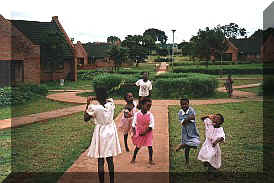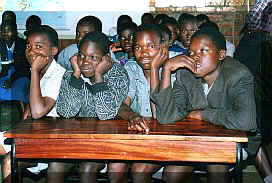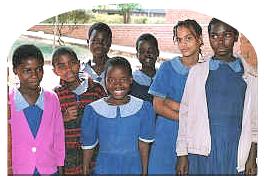Introduction
- Primary School System
Most children
start formal education at primary school at the age of six. The primary
school takes 8 years from standard 1 to 8 at the end of which pupils write
the Primary School Leaving Certificate examinations. These are jointly
set, conducted and marked by the Ministry of Education and the Malawi National
Examinations Board (MANEB). Students have to pass and get selected if they
are to attend secondary
school education in a government secondary
school.
The introduction of Free
Primary Education in Malawi has seen a large increase in
the number
of pupils going to primary school but this increase in access has also
brought major infrastructure problems and a big decline in quality.
To help manage the many primary
schools in Malawi, the Ministry of Education has created Education
Divisions
which group primary schools into smaller groups for management purposes.
A policy framework has been developed to enable
the
provision of education
needs to be well-planned, and priorities drawn out.
Education
Divisions for Primary Schools
Malawi has been divided into
six Education Divisions namely:-
-
South West Division (Chikwawa,
Blantyre Rural, Blantyre Urban,Mwanza, Nsanje)
-
South East Division (Zomba Rural,
Zomba Urban, Balaka, Mangochi, Machinga)
-
Shire Highlands Division
(Mulanje, Chiradzulu, Thyolo, Phalombe)
-
Central West Division
(Lilongwe Rural, Lilongwe Urban, Mchinji, Ntcheu, Dedza)
-
Central East Division
(Kasungu, Dowa, Ntchisi, Salima, Nkhotakota)
-
North Division (Mzuzu,
Mzimba, Karonga, Chitipa, Nkhatabay, Rumphi)
These Education Divisions comprise
of 4-6 Education Districts. These divisions are further divided into zones
and each zone has 6 - 10 primary schools. On average a single primary school
contains up to 3000 pupils and an average of 350 teachers. This form of
grouping is done for easy management of the schools.
Every year the Ministry of
Education prepares an Annual Primary School Census Questionnaire which
is distibuted to every primary school. The purpose of this questionnaire
is to find out general information about the school.This information includes:-
-
School Identification Data
:- When the school was established, the current Headmaster,Head Teacher,
School phone number, School Registration number, Location of the school,
School address, the proprieter of the school,
-
School Enrollment Data :-
records are submitted by Age, Sex and Standard, repeaters by Sex and
Standard, transfers in by Sex and Standard, transfers out by Sex and Standard,
the previous years dropouts and also teachers by qualification.
-
Physical Facilities:-
these include classrooms, staffroom, workshop, teachers houses, water toilets,
pit latrines, kitchen, hostels, electricity, tables, chairs.
-
Supplies and Textbooks:-
this checks wether supplies to the school are adequate or inadequate i.e.
footballs, netballs, notebooks, textbooks, pencils, pens, registers, chalk
etc.
-
Teacher's Data :- Statistics
are collected of all the teachers i.e. Sex, Date of birth, standard they
are teaching, teaching qualification, total teaching periods, first appointment
to education service.
For private schools to be recognised
they obtain a license from the government and after registering they get
a center number so the center can administer Primary School Leaving Certificate
Examinations. For a private primary school student to get selected to a
government secondary he has to apply directly to the Ministry of Education
so that they can decide his eligibility.
Free Primary
School Education
 The
introduction of Free Primary Education in Malawi has seen a large increase
in the number of children going to primary school. In effect more Malawians
are being educated and hence the whole nation is moving towards literacy
and a well-informed society with sound judgement and reasoning, where individuals
are able to communicate with each other on the same level. A basic education
is essential for someone to understand how the world works and to appreciate
the value of the property one has. In Malawi it is essential for each individual
to be able to appeciate what one has. Education helps build ideas in ones
mind, without basic education even an intelligent child would not be able
to develop to his full potential.
The
introduction of Free Primary Education in Malawi has seen a large increase
in the number of children going to primary school. In effect more Malawians
are being educated and hence the whole nation is moving towards literacy
and a well-informed society with sound judgement and reasoning, where individuals
are able to communicate with each other on the same level. A basic education
is essential for someone to understand how the world works and to appreciate
the value of the property one has. In Malawi it is essential for each individual
to be able to appeciate what one has. Education helps build ideas in ones
mind, without basic education even an intelligent child would not be able
to develop to his full potential.
Despite the advantages free education
has also brought with it a lot of problems: -
-
Infrastructure: - Children have
to learn under trees because there are more children attending primary
schools and not enough classrooms to house the children. As a result Children
are being denied the chance to learn under normal conditions due to scarce
resources e.g. desks, books, teaching materials etc. Children are also
exposed to hardships beyond their age due to lack of classrooms e.g. cold,
rain, and wind since most of them are learning outside.
-
Hygiene: - Children have to live
in an environment that has very poor sanitation, most of the toilets and
water taps have been vandalised and those that have not do not work properly.
-
Teachers: - The Government has
made provisions that for every 60 children there is a teacher allocated
but in most cases you will find three teachers sharing 200 students in
one class and dividing the subjects between them. This does not help the
concentration of the children and neither that of the teacher. There is
no way a teacher can pay attention to 200 pupils.
-
Public attitude: - Both the etchers,
the public and the pupils are misunderstanding the word "free" they have
an attitude that implies that since education is free they only teach if
they want or not and similarly with children. The idea behind Free Primary
Education is that education is free but the rules and regulations still
apply to both teachers and pupils in the schools. There is also a general
attitude that says government should do everything for us when that should
not be the case at all.
The government has put in pace Free Primary
Education for the good of the nation and it is up to the public, parents,
teachers and students to make it work.
Protection
of Children
Most children start formal
education at the age of six. And since most of the children attending primary
school are between the ages of 6 - 14 and are aslo in large numbers it
is difficult for the government to provide protection for students, some
of the protective measures put in place include: -
-
The Ministry of Education has ensured
that within a 3 km radius of every household there is a primary school
and therefore children do not have to travel for more than 3 km to get
to a primary school. If parents chose to send their children to schools
that are miles away then they are doing it at their own risk .
-
In most primary schools due to the large
numbers some of the pupils attend school in the morning and the others
in the afternoon, the younger children attend school in the morning so
as to ensure that they get to home in time for lunch.
-
Children in lower classes are also encouraged
to travel in large when going to and from their respective school to ensure
their safety.
-
Where the schools by the main roads Zebra
Crossing have been put in to ensure easy road crossing by the children.
Protective measures have been put in to
the best of the government’s ability but the public should help protect
these children, as they are our future.
Student
Behavior
 When
a child goes to primary school it is at the age when he is keen to learn
and explore and also a time when children need more guidance. The general
behavior of primary school children in Malawi is decent and has resulted
in a high passrate in the Primary School Leaving Certificate Examinations.
When
a child goes to primary school it is at the age when he is keen to learn
and explore and also a time when children need more guidance. The general
behavior of primary school children in Malawi is decent and has resulted
in a high passrate in the Primary School Leaving Certificate Examinations.
Most of the children are willing to
listen to their teachers and learn from them, but it is very difficult
to discipline a class of 200 children and hence some rowdy behavior still
develops.
Most problematic behavior is seen in
higher classes e.g. standard seven and eight where young girls have to
dropout of school due to teenage pregnancies. Most of this also results
from the fact that children are starting school at an older age and therefore
reach adolescence while still in primary school. There are many NGOs that
are looking into problems of this nature and are working with the government
to help prevent such outcomes.
Moving on
to Secondary School
The primary school education takes
eight years from standard 1 to 8 at the end of which pupils write the Primary
School Leaving Certificate examinations. These are set, conducted and marked
by the Malawi National Examinations Board (MANEB). All the results are
then sent to the Ministry of Education, which sets the standards for selection
to National Secondary Schools. The results are then sent to the districts
for selection into Community Day Secondary Schools. Committees consisting
of Headmasters from cachement primary schools and the Community Day Secondary
School in question select students to go to this school.
If a child is selected and cannot afford
secondary school fees bursaries have been set aside by the government so
that no child should fail to go to get a secondary school education because
of lack of funding.
Girls who are pregnant at the time
secondary school starts are allowed to take time off and just register
with the school and start in the next academic year. One might argue that
this encourages students to miss behave but it has been observed that the
students given this opportunity come back stronger and more determined
to continue with their education and are among the most successful in their
classes.
Introduction
| Education
Divisions | Free Primary
| Student Protection
| Student Behavior
| After Primary
Copyright
2001 Malawi SDNP. All rights Reserved.


 The
introduction of Free Primary Education in Malawi has seen a large increase
in the number of children going to primary school. In effect more Malawians
are being educated and hence the whole nation is moving towards literacy
and a well-informed society with sound judgement and reasoning, where individuals
are able to communicate with each other on the same level. A basic education
is essential for someone to understand how the world works and to appreciate
the value of the property one has. In Malawi it is essential for each individual
to be able to appeciate what one has. Education helps build ideas in ones
mind, without basic education even an intelligent child would not be able
to develop to his full potential.
The
introduction of Free Primary Education in Malawi has seen a large increase
in the number of children going to primary school. In effect more Malawians
are being educated and hence the whole nation is moving towards literacy
and a well-informed society with sound judgement and reasoning, where individuals
are able to communicate with each other on the same level. A basic education
is essential for someone to understand how the world works and to appreciate
the value of the property one has. In Malawi it is essential for each individual
to be able to appeciate what one has. Education helps build ideas in ones
mind, without basic education even an intelligent child would not be able
to develop to his full potential.
 When
a child goes to primary school it is at the age when he is keen to learn
and explore and also a time when children need more guidance. The general
behavior of primary school children in Malawi is decent and has resulted
in a high passrate in the Primary School Leaving Certificate Examinations.
When
a child goes to primary school it is at the age when he is keen to learn
and explore and also a time when children need more guidance. The general
behavior of primary school children in Malawi is decent and has resulted
in a high passrate in the Primary School Leaving Certificate Examinations.